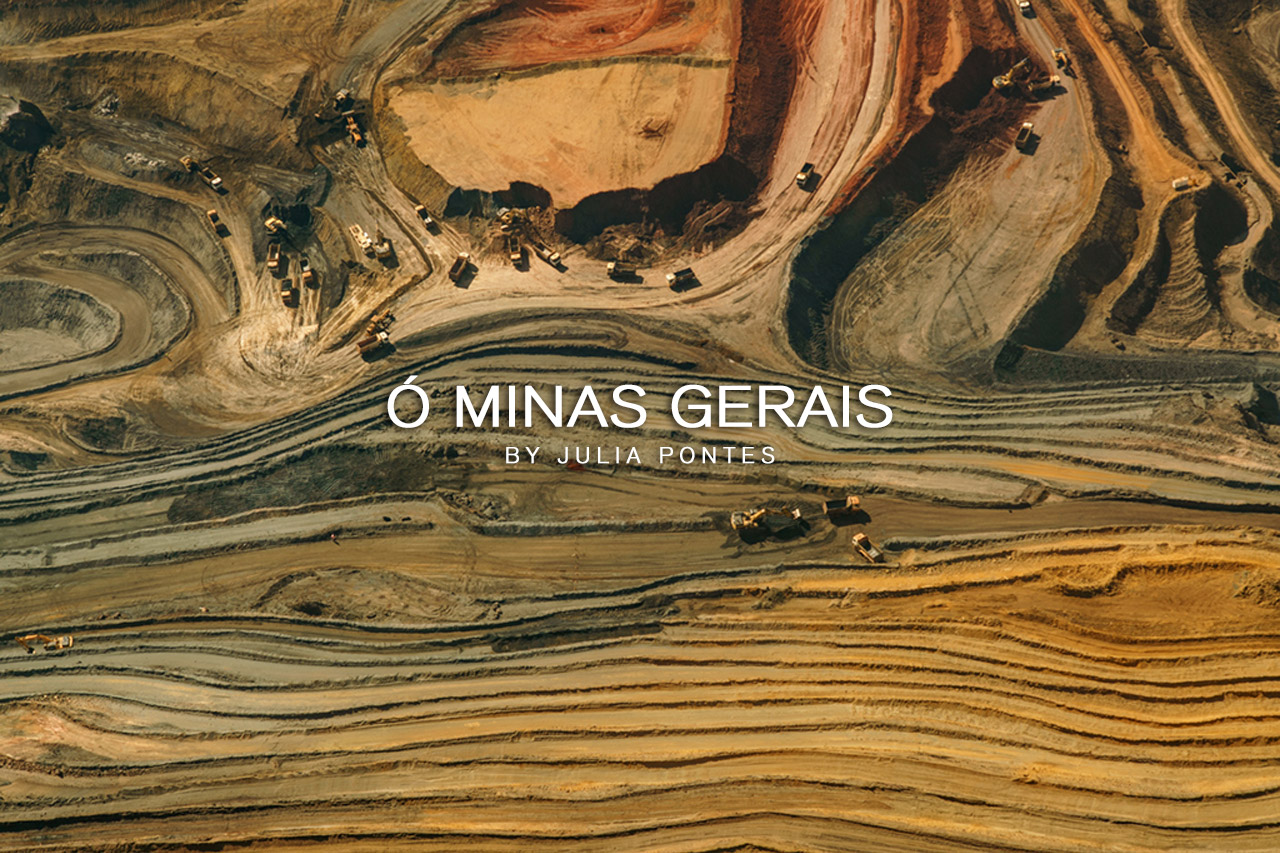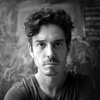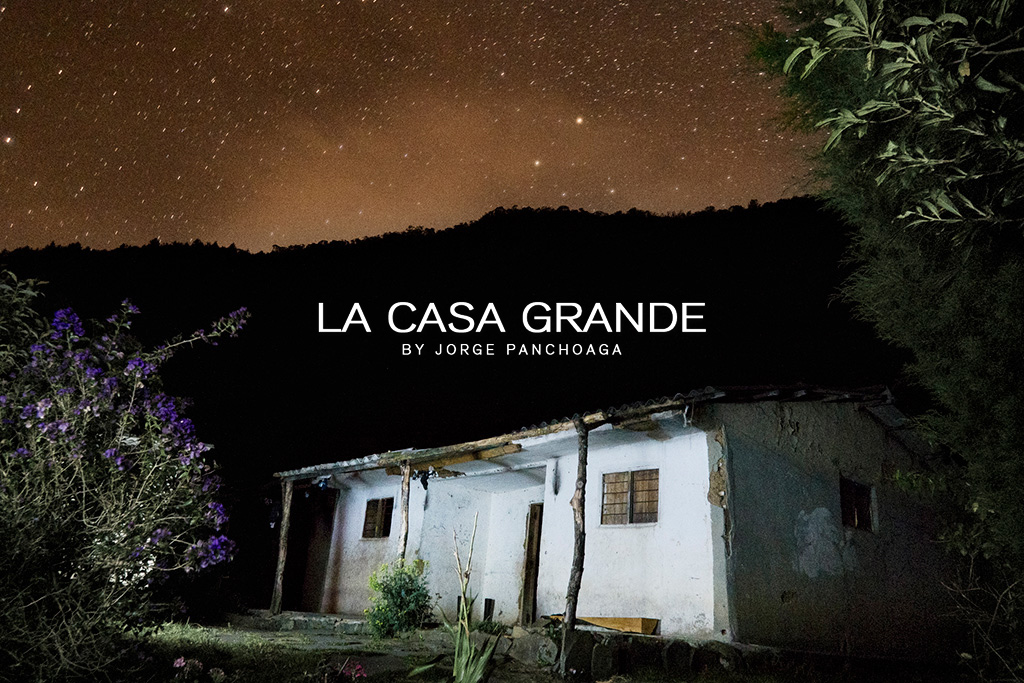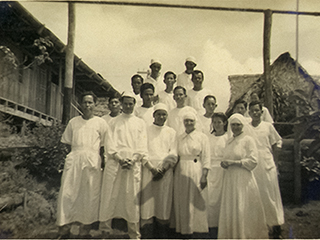Júlia Pontés

Brazil is facing the largest environmental disaster in its history. Due the lack of specific regulations and low inspection, a mining company’s dam broke throwing 10.5 billion gallons of mud on one of the countries most important rivers and water sheds, covering a whole town and leaving many cities without water.
That breakage served as a groundbreaking for me. While flying over the area I was impressed by the landscape damaged that has been caused by the highly intensive mining activity in the state. Many of the open air mines, are hidden between the state of Minas Gerais’ “mountain” chains , therefore, local population has no sight of its extension. Most of the photographs were taken in a forbidden aerial space, with the plane’s transponder being off.
It is a very delicate subject, mining is the main industry in the state and it is so deeply routed that it is on it’s name. Everyone has a relation to the activity. My family had an iron processing company, one of the multiple stages on the mining commercial chain.
There is a mining regulation bill currently being discussed by Brazilian congressman. 20 out of the 27 congressman responsible for the project received money from mining companies to their campaigns.
This ongoing project is a landscape investigation both of the disaster, the unbounded and poorly regulated use of the soil.




















 Júlia Pontés (Brazil, 1983).Porteña by choice - Live & work in New York Her interests are influenced by Psychology and Public Policies, in which she holds a Master’s Degree. She graduated at the International Center of Photography and she has been chosen as an Emerging Immigrant Artist by the New York Foundation for the Arts, where she has been a mentee twice. She has a polarized practice that involves documenting stories linked to her own life experiences and, on the other hand, a self portraiture practice. In both she applies experimental techniques, the use of different mediums and archive material.
Júlia Pontés (Brazil, 1983).Porteña by choice - Live & work in New York Her interests are influenced by Psychology and Public Policies, in which she holds a Master’s Degree. She graduated at the International Center of Photography and she has been chosen as an Emerging Immigrant Artist by the New York Foundation for the Arts, where she has been a mentee twice. She has a polarized practice that involves documenting stories linked to her own life experiences and, on the other hand, a self portraiture practice. In both she applies experimental techniques, the use of different mediums and archive material.
Brazil is facing the largest environmental disaster in its history. Due the lack of specific regulations and low inspection, a mining company’s dam broke throwing 10.5 billion gallons of mud on one of the countries most important rivers and water sheds, covering a whole town and leaving many cities without water.
That breakage served as a groundbreaking for me. While flying over the area I was impressed by the landscape damaged that has been caused by the highly intensive mining activity in the state. Many of the open air mines, are hidden between the state of Minas Gerais’ “mountain” chains , therefore, local population has no sight of its extension. Most of the photographs were taken in a forbidden aerial space, with the plane’s transponder being off.
It is a very delicate subject, mining is the main industry in the state and it is so deeply routed that it is on it’s name. Everyone has a relation to the activity. My family had an iron processing company, one of the multiple stages on the mining commercial chain.
There is a mining regulation bill currently being discussed by Brazilian congressman. 20 out of the 27 congressman responsible for the project received money from mining companies to their campaigns.
This ongoing project is a landscape investigation both of the disaster, the unbounded and poorly regulated use of the soil.




















 Júlia Pontés (Brazil, 1983).Porteña by choice - Live & work in New York Her interests are influenced by Psychology and Public Policies, in which she holds a Master’s Degree. She graduated at the International Center of Photography and she has been chosen as an Emerging Immigrant Artist by the New York Foundation for the Arts, where she has been a mentee twice. She has a polarized practice that involves documenting stories linked to her own life experiences and, on the other hand, a self portraiture practice. In both she applies experimental techniques, the use of different mediums and archive material.
Júlia Pontés (Brazil, 1983).Porteña by choice - Live & work in New York Her interests are influenced by Psychology and Public Policies, in which she holds a Master’s Degree. She graduated at the International Center of Photography and she has been chosen as an Emerging Immigrant Artist by the New York Foundation for the Arts, where she has been a mentee twice. She has a polarized practice that involves documenting stories linked to her own life experiences and, on the other hand, a self portraiture practice. In both she applies experimental techniques, the use of different mediums and archive material.Pedro David

Brazillian country side is being filled with eucalyptus.
The accelerated industrial development and the overtuned importance of steel exportation, lead by sucessive governments, are one of the reasons of the deforestation of the Cerrado, the Brazillian savana, the Atlantic Forest, and even the Amazon.
Several international steel companies, established by the country, buys large portions of land and substitutes the natural vegetation by transgenic eucalyptus trees, a fast growing kind of wood, used to make vegetal coal, an important ingredient in the tranformation of the iron ore to steel.
The eucalyptus charges high the environment for it’s fast growing speed: it consumes too much water and nutrients, leaving the soil exhausted and dry.
I’m working in some regions affected by these monocrops since my beginning as a photographer. The extensive and visually growing areas of the eucaliptus fields always concerned me, because of the environmental and also social impact it brings, changing the landscape as a whole, the geographical references, the natural resources, the economical activities, and the amount of water, now a global issue. I’ve ridden, and walked, a lot inside these fields since 2002.
I’ve photographed several situations trying to discuss this question in the last 13 years. But when, in a recent travel, I passed by road swallowed by an enormous eucaliptus field, I faced one of this hybrid scenes and saw the opportunity to make a representative image of the situation, a straight photograph containing: the past, a native tree, something that is desappearing of those landscapes, the future: those supra-vegetal, eucaliptus clones, in the present of the photography.
Besides this documentary facet, that is being effective to sensibilize people of the problem of the extensive growing of this and other kinds of monocrops, a basic Brazillian problem, I also see this work in a simbolic way. I note that people feel something beyond the direct meaning of these photographs, something like a direct identification with these encaged lifes, struggling to survive in an artificial, oppressive and vanishing world.


















 Pedro David (Brazil, 1977). He graduated in journalism in 2002. His works are in public and private photographic collections. He has received the Situações Brasília Contemporary Art Prize in 2012 and 2014; Conrado Wessel Foundation Prize of Photography, in 2013, Itamaraty Prize for Contemporary Art in 2012 and 2013; Arte Pará Prize in 2012; Pierre Verger Prize of Photography, in 2011; Latin Union - Martín Chambi Protography Prize, in 2010, and the 5thPorto Seguro Brasil Award. He has published the books: Fase Catarse (Catharsis Phase), 2014; Rota Raiz (Route Root) Tempo D’Imagem, 2013; O Jardim (The Garden) Funceb, 2012 and Paisagem Submersa (Underwater Landscape) Cosac Naify, 2008.
Pedro David (Brazil, 1977). He graduated in journalism in 2002. His works are in public and private photographic collections. He has received the Situações Brasília Contemporary Art Prize in 2012 and 2014; Conrado Wessel Foundation Prize of Photography, in 2013, Itamaraty Prize for Contemporary Art in 2012 and 2013; Arte Pará Prize in 2012; Pierre Verger Prize of Photography, in 2011; Latin Union - Martín Chambi Protography Prize, in 2010, and the 5thPorto Seguro Brasil Award. He has published the books: Fase Catarse (Catharsis Phase), 2014; Rota Raiz (Route Root) Tempo D’Imagem, 2013; O Jardim (The Garden) Funceb, 2012 and Paisagem Submersa (Underwater Landscape) Cosac Naify, 2008.
Brazillian country side is being filled with eucalyptus.
The accelerated industrial development and the overtuned importance of steel exportation, lead by sucessive governments, are one of the reasons of the deforestation of the Cerrado, the Brazillian savana, the Atlantic Forest, and even the Amazon.
Several international steel companies, established by the country, buys large portions of land and substitutes the natural vegetation by transgenic eucalyptus trees, a fast growing kind of wood, used to make vegetal coal, an important ingredient in the tranformation of the iron ore to steel.
The eucalyptus charges high the environment for it’s fast growing speed: it consumes too much water and nutrients, leaving the soil exhausted and dry.
I’m working in some regions affected by these monocrops since my beginning as a photographer. The extensive and visually growing areas of the eucaliptus fields always concerned me, because of the environmental and also social impact it brings, changing the landscape as a whole, the geographical references, the natural resources, the economical activities, and the amount of water, now a global issue. I’ve ridden, and walked, a lot inside these fields since 2002.
I’ve photographed several situations trying to discuss this question in the last 13 years. But when, in a recent travel, I passed by road swallowed by an enormous eucaliptus field, I faced one of this hybrid scenes and saw the opportunity to make a representative image of the situation, a straight photograph containing: the past, a native tree, something that is desappearing of those landscapes, the future: those supra-vegetal, eucaliptus clones, in the present of the photography.
Besides this documentary facet, that is being effective to sensibilize people of the problem of the extensive growing of this and other kinds of monocrops, a basic Brazillian problem, I also see this work in a simbolic way. I note that people feel something beyond the direct meaning of these photographs, something like a direct identification with these encaged lifes, struggling to survive in an artificial, oppressive and vanishing world.


















 Pedro David (Brazil, 1977). He graduated in journalism in 2002. His works are in public and private photographic collections. He has received the Situações Brasília Contemporary Art Prize in 2012 and 2014; Conrado Wessel Foundation Prize of Photography, in 2013, Itamaraty Prize for Contemporary Art in 2012 and 2013; Arte Pará Prize in 2012; Pierre Verger Prize of Photography, in 2011; Latin Union - Martín Chambi Protography Prize, in 2010, and the 5thPorto Seguro Brasil Award. He has published the books: Fase Catarse (Catharsis Phase), 2014; Rota Raiz (Route Root) Tempo D’Imagem, 2013; O Jardim (The Garden) Funceb, 2012 and Paisagem Submersa (Underwater Landscape) Cosac Naify, 2008.
Pedro David (Brazil, 1977). He graduated in journalism in 2002. His works are in public and private photographic collections. He has received the Situações Brasília Contemporary Art Prize in 2012 and 2014; Conrado Wessel Foundation Prize of Photography, in 2013, Itamaraty Prize for Contemporary Art in 2012 and 2013; Arte Pará Prize in 2012; Pierre Verger Prize of Photography, in 2011; Latin Union - Martín Chambi Protography Prize, in 2010, and the 5thPorto Seguro Brasil Award. He has published the books: Fase Catarse (Catharsis Phase), 2014; Rota Raiz (Route Root) Tempo D’Imagem, 2013; O Jardim (The Garden) Funceb, 2012 and Paisagem Submersa (Underwater Landscape) Cosac Naify, 2008.Bruno Bresani






















 Bruno Bresani (Brasil, 1973). Lives and works in Mexico. Photographer. He has completed three masters: Production and Artistic Research at the University of Barcelona, Digital Arts at the University Pompeu Fabra and Visual Arts at the National School of Plastic Arts at the UNAM. He has participated in several festivals and exhibitions in various cities in Mexico, the United Kingdom, Portugal, Austria, Argentina, Colombia, Morocco, Cuba and Spain. To see more of his work go to: brunobresani.blogspot.mx/
Bruno Bresani (Brasil, 1973). Lives and works in Mexico. Photographer. He has completed three masters: Production and Artistic Research at the University of Barcelona, Digital Arts at the University Pompeu Fabra and Visual Arts at the National School of Plastic Arts at the UNAM. He has participated in several festivals and exhibitions in various cities in Mexico, the United Kingdom, Portugal, Austria, Argentina, Colombia, Morocco, Cuba and Spain. To see more of his work go to: brunobresani.blogspot.mx/





















 Bruno Bresani (Brasil, 1973). Lives and works in Mexico. Photographer. He has completed three masters: Production and Artistic Research at the University of Barcelona, Digital Arts at the University Pompeu Fabra and Visual Arts at the National School of Plastic Arts at the UNAM. He has participated in several festivals and exhibitions in various cities in Mexico, the United Kingdom, Portugal, Austria, Argentina, Colombia, Morocco, Cuba and Spain. To see more of his work go to: brunobresani.blogspot.mx/
Bruno Bresani (Brasil, 1973). Lives and works in Mexico. Photographer. He has completed three masters: Production and Artistic Research at the University of Barcelona, Digital Arts at the University Pompeu Fabra and Visual Arts at the National School of Plastic Arts at the UNAM. He has participated in several festivals and exhibitions in various cities in Mexico, the United Kingdom, Portugal, Austria, Argentina, Colombia, Morocco, Cuba and Spain. To see more of his work go to: brunobresani.blogspot.mx/Cia de Foto
Out of all the projects carried out by Cia de Foto, this is undoubtedly the most subjective one, as it shares a space that tests the coexistence of the members, their daily life and also the material that unites them: intimacy and affection. To paraphrase Duchamp, this is a “definitely unfinished” project , with an uncertain beginning point, which starts with time undefined in memory and includes formats as varied as those that can be found when one opens a box full of photographs.
In this manner, and following a request by the curator, Eder Chiodetto, this project was integrated into the Collectors’ club of the MAM (Museu de Arte Moderna) in São Paulo, through a video edit with a soundtrack by DJ Guab. The version presented here became the most famous one.
 Cia de foto (Brazil, 2003). Photography Co. (Brazil, 2003). Brazilian photography collective whose works employ various visual languages, questioning the context and multiple meanings of the image. Using theoretical and experimental research, they seek to expand the limits of photographic perspectives. They have taken part in several national and international exhibitions, and collaborated in organizing seminars, publications, festivals and curatorships with photography as the central theme. Their work can be viewed at ciadefoto.com
Cia de foto (Brazil, 2003). Photography Co. (Brazil, 2003). Brazilian photography collective whose works employ various visual languages, questioning the context and multiple meanings of the image. Using theoretical and experimental research, they seek to expand the limits of photographic perspectives. They have taken part in several national and international exhibitions, and collaborated in organizing seminars, publications, festivals and curatorships with photography as the central theme. Their work can be viewed at ciadefoto.comOut of all the projects carried out by Cia de Foto, this is undoubtedly the most subjective one, as it shares a space that tests the coexistence of the members, their daily life and also the material that unites them: intimacy and affection. To paraphrase Duchamp, this is a “definitely unfinished” project , with an uncertain beginning point, which starts with time undefined in memory and includes formats as varied as those that can be found when one opens a box full of photographs.
In this manner, and following a request by the curator, Eder Chiodetto, this project was integrated into the Collectors’ club of the MAM (Museu de Arte Moderna) in São Paulo, through a video edit with a soundtrack by DJ Guab. The version presented here became the most famous one.
 Cia de foto (Brazil, 2003). Photography Co. (Brazil, 2003). Brazilian photography collective whose works employ various visual languages, questioning the context and multiple meanings of the image. Using theoretical and experimental research, they seek to expand the limits of photographic perspectives. They have taken part in several national and international exhibitions, and collaborated in organizing seminars, publications, festivals and curatorships with photography as the central theme. Their work can be viewed at ciadefoto.com
Cia de foto (Brazil, 2003). Photography Co. (Brazil, 2003). Brazilian photography collective whose works employ various visual languages, questioning the context and multiple meanings of the image. Using theoretical and experimental research, they seek to expand the limits of photographic perspectives. They have taken part in several national and international exhibitions, and collaborated in organizing seminars, publications, festivals and curatorships with photography as the central theme. Their work can be viewed at ciadefoto.com




